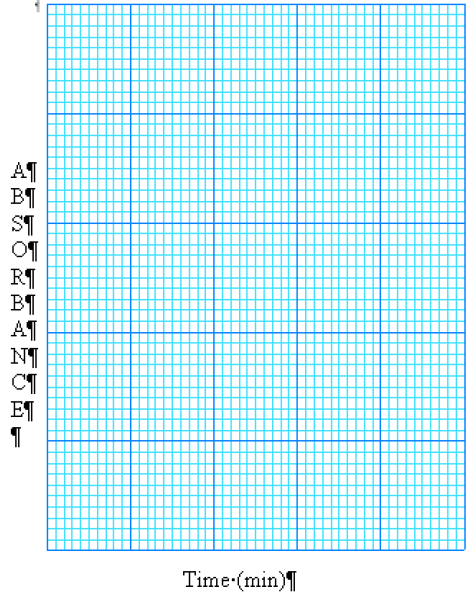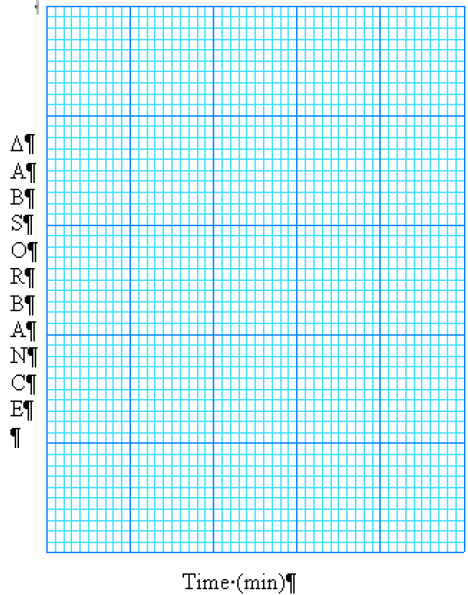2.19: Kinetic Enzyme Analysis
- Page ID
- 120238
RELATED READINGS: Chapters 54 and 55. See Methods Aspartate aminotransferase, or Amylase, or Gamma-glutamyl transferase.
OBJECTIVES
Upon completion of this exercise, appropriate readings, and
discussions, the student will be able to:
- Perform a kinetic enzyme procedure.
- Construct a graph to illustrate the relationship between time and absorbance change during an enzymatic reaction.
- Calculate the amount of enzyme activity present in the sample.
PRINCIPLE
For most enzyme assays, if the activity is plotted against time, a curve with 3 general phases would usually be generated. A typical curve would appear as shown below.

The lag phase is the period during which temperature and kinetic equilibrium is established. The linear portion is the phase of zero order kinetics and is the phase during which analysis is usually performed. The substrate depletion phase occurs when one or more of the substrates is depleted.
MATERIALS
- Enzyme Reagent
- Graph paper
- Serum Sample Incubators
- Spectrophotometer (UV)
- 37°C incubator
PROCEDURE
- Pipet 2.0 mL of enzyme reagent into a clean 12mm x 75mm cuvette.
- Add 100 \(\mu\)L of sample to the enzyme reagent.
- Mix well.
- Incubate at 37°C for 1 minute.
- Adjust the wavelength of a spectrophotometer to 340 nm (or any other wavelength necessary for the reaction to be monitored).
- Blank the Instrument (set 100% T, zero absorbance) with distilled water.
- Measure and record the absorbance of the solution after the initial 1 minute and each minute thereafter for a total time of 15 minutes. Return the cuvette to the incubator between readings.
- Plot the absorbance readings on the vertical axis versus time on the horizontal axis using linear graph paper. Connect your points to form a smooth curve.
- Plot the \(Delta\)A values on the vertical axis of the second graph versus time on the horizontal axis. Connect the points to form a smooth curve.
Discussion Questions
- Propose an explanation for the shape of the absorbance vs time graph. Mark the lag, linear, and substrate depletion areas on your graph.
- What are the relationships between the two graphs (A versus time and \(\Delta\)A versus time)?
- Why did the calculated enzyme concentrations differ at the different time points?
- What would the effect on the calculated enzyme activity be if the sample volume in the experiment were halved?
| DATA SHEET, EXERCISE #19 |
NAME: ___________ DATE: ___________ |
RESULTS
| Time (min) |
Absorbance | \(\Delta\)A | Calculated enzyme activity |
|---|---|---|---|
| 1 | |||
| 2 | |||
| 3 | |||
| 4 | |||
| 5 | |||
| 6 | |||
| 7 | |||
| 8 | |||
| 9 | |||
| 10 | |||
| 11 | |||
| 12 | |||
| 13 | |||
| 14 | |||
| 15 |
Calculate the amount of enzyme activity at the time points indicated above using the following formula:
\[\text{U/L specimen} = \frac{\Delta A/min \times \text{total assay volume (mL)} \times 1000\; mL/L}{\text{abs. coeff.} \times \text{lightpath (cm)} \times \text{sample vol.(mL)}}\]
\(\Delta\)A = change in absorbance
1000 mL/L = factor to convert units/mL to U/L
abs.coeff. = Absorbance coefficient = 6.22 cm-1 x L x mmole-1 for NADH at 340nm



